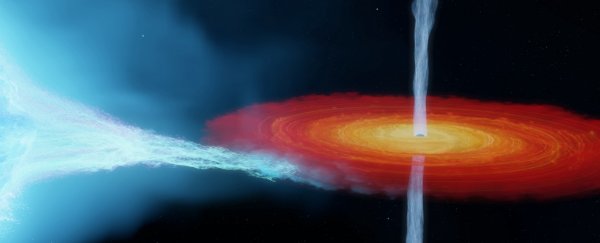Astronomers have revisited the very first stellar-mass black hole ever identified, and found that it's at least 50 percent more massive than we thought.
The black hole in the X-ray binary system Cygnus X-1 has been recalculated to clock in at 21 times the mass of the Sun. That makes it the most massive stellar-mass black hole ever detected without the use of gravitational waves, and it's forcing astronomers to rethink how black holes form.
Cygnus X-1 was first discovered as an X-ray source in 1964, and its status as a black hole went on to become the subject of a wager between astrophysicists Stephen Hawking and Kip Thorne.
Scientists later validated the black hole interpretation of the object's nature, concluding that the X-ray emission was produced by the black hole snacking on a binary companion.
It's become one of the most studied black holes in the sky, and astronomers thought that it was fairly well understood: an object around 6,070 light-years away, with a mass of 14.8 solar masses, and a blue supergiant binary companion named HDE 226868 clocking in at around 24 solar masses.
We were, according to new observations, wrong.
Astronomers have conducted new parallax observations of the system, watching how it appears to 'wobble' in the sky as Earth orbits the Sun, using the Very Long Baseline Array, a collection of radio telescopes acting together as one continent-sized collecting dish.
Ultimately, their observations showed that Cygnus X-1 is quite a significant distance farther than we thought. Which means the objects themselves are significantly larger.
"We used radio telescopes to make high-precision measurements of Cygnus X-1 - the first black hole ever discovered," explained astronomer James Miller Jones from the International Centre for Radio Astronomy Research (ICRAR) in Australia.
"The black hole is in a few-day orbit with a massive companion star. By tracking for the first time the black hole's orbit on the sky, we refined the distance to the system, placing it over 7,000 light-years from Earth.
"This implied that the black hole was over 20 times the mass of our Sun, making it the most massive stellar-mass black hole ever discovered without the use of gravitational waves. This challenges our ideas of how massive stars evolve to form black holes."
Previously, the most massive stellar-mass black hole detected electromagnetically was M33 X-7, clocking in at 15.65 times the mass of the Sun. At the time of its discovery, even M33 X-7 challenged our black hole formation models.
Scientists concluded that, as the massive star that would collapse down to form the black hole reached the end of its life, it lost mass more slowly than models suggested. They believe something similar for Cygnus X-1.
"Stars lose mass to their surrounding environment through stellar winds that blow away from their surface. But to make a black hole this heavy, we need to dial down the amount of mass that bright stars lose during their lifetimes," said theoretical astrophysicist Ilya Mandel from the ARC Centre of Excellence in Gravitational Wave Discovery (OzGrav) in Australia.
The precursor star to the Cygnus X-1 black hole would have started out at around 60 solar masses, blasting off its outer material before the core likely directly collapsed down into the dense object it is today, bypassing a supernova explosion.
Now, it is locked in an incredibly close, 5.6-day orbital dance with its blue supergiant companion, which now also has a revised mass, bringing it up to a chunky 40 solar masses.
That's massive enough that it, too, should one day end up as a black hole, forming a binary black hole similar to those seen in the mergers that generate gravitational waves.
It is, however, unlikely that the binary would merge soon. The refined distance measurement will also allow astronomers to recalculate other characteristics of Cygnus X-1. In a separate paper, astronomers found that it's spinning nearly as fast as the speed of light. That's faster than any other black hole ever measured.
This is in direct contrast with gravitational wave binaries, which have very slow, or misaligned, spins. This suggests that Cygnus X-1 followed a different evolutionary pathway than the black hole binaries we have seen merge.
Given the distance between Cygnus X-1 and HDE 226868, the researchers have calculated that the pair are unlikely to merge within a timescale equal to the age of the Universe - 13.8 billion years.
Studying the system now, before that second black hole collapse happens, presents a rare opportunity for understanding black hole binaries.
"Observations like these directly tell us a lot about the evolutionary pathways that are possible in making double black holes, some of which ground-based gravitational wave detectors like LIGO and Virgo have been regularly finding," said physicist Ashley Ruiter of the University of New South Wales Canberra in Australia, who was not involved in the research.
"It's great we can still catch the binary 'in action' with electromagnetic light before it forms a double black hole - it helps to refine our theories about close binary star evolution."
The team's research has been published in Science.
